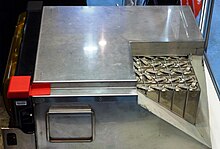Thermal battery
As a thermal battery (also high temperature battery ) are batteries referred to the solid in the storage state electrolytes contain and are inactive. The electrolytes only melt at high temperatures (200–800 ° C), which activates the battery.
construction
Salts such as sodium chloride , potassium chloride or lithium chloride are used as electrolytes , which is why these batteries are also referred to as melting salt batteries . Lithium alloys ( lithium silicon or lithium aluminum ), previously also calcium or magnesium, and chromates or sulfides (e.g. potassium chromate , iron sulfide and cobalt sulfide ) for the cathodes are used as anode material . Due to the high temperature and the properties of the molten electrolytes, they have a high conductivity and thus a high power density.
commitment
Primary cells of this type (e.g. special lithium iron sulfide batteries ) are used in applications where a very long shelf life and reliability are important and the service life is rather short (a few seconds to minutes). With them, the electrolyte is only melted by a pyrotechnic charge when the battery is used, thereby activating the battery. Such batteries are used almost exclusively in the military sector and in space travel. They are used, for example, in missiles such as the 9K38 Igla , AIM-9 Sidewinder , BGM-109 Tomahawk , but also in atomic bombs . Another use case was the landing phase of the Mars Science Laboratory in 2012.
But also secondary cells , i. H. Rechargeable batteries of this type, such as the sodium-nickel chloride battery (so-called ZEBRA battery) or the sodium-sulfur battery , have been used in various experimental applications in electric cars and battery storage power plants since the 1990s .
history
Thermally activated batteries were already used in Germany in the V2 rocket . They were developed by Georg Otto Erb on the basis of calcium chromate .
swell
- Thermal Batteries . corrosion doctors
- Battery Lexicon . EMB accumulators
- Ronald A. Guidotti: Thermal Batteries: A Technology Review and Future Directions . In: 27th International SAMPE Technical Conference Albuquerque, NM October 9-12, 1995.

